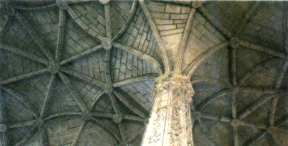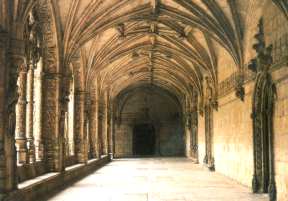|
|
|
|
WORLD HERITAGE SITES IN PORTUGAL
MONASTERY OF JERONIMOS
MOSTEIRO DE SANTA MARIA DE BELEM – JERONIMOS
The Mosteiro dos Jeronimos and the Torre de Belem are the supreme architectural representatives of a period in which the Portuguese nation played a leading role, expanding the horizons of both Europe and the world. They were erected symbolically in Belem, which, in the sixteenth century, was the site of the port from which the caravelas and other large ships set sail on the great voyages of the Portuguese maritime discoveries. Today, now that both the port and beach have disappeared, the site has become a pleasant leisure area. A small chapel - Santa Maria de Belem - was built here at the behest of Prince Henry the Navigator on the site where the Mosteiro dos Jeronimos now stands. The monastery was itself commissioned by D. Manuel I. The magnificence of the building reflects the universalist vision of its founder and the powerful financial resources that the Portuguese crown then enjoyed.
The sixteenth century in Portugal was profoundly connected to the Discoveries and the Messianic idea of the Empire, inspiring a unique style that came to be known as ''Manueline'', since it was developed in the reign of D. Manuel I. The decorative features carved out of the monastery' s stone (many of which, such as ropes, fish and conches, were inspired by the sea) should be studied carefully for they are perhaps the most stimulating way of discovering more about this unique contribution that Portugal made to the art of stonework.

The monument's original design is the work of the architect Boytac, and its construction began in I502. This was the initial phase of building work that was to be continued by other Masters, namely Joao de Castilho and, in the middle of the century, Diogo de Torralva.Begin by observing the south-facing facade, whose main feature of interest is the portal, the work of Joao de Castilho, surmounted by a tympanum of carved stone, including low reliefs showing scenes from the life of St. Jerome and the royal coat of arms. In the centre is a statue of Prince Henry the Navigator wielding a sword and, at the upper level, a statue of Our Lady of Belem, covered by a finely carved canopy. The whole of the portal seems to be physically raising itself skywards, with the figure of the Archangel Gabriel, Portugal's guardian angel, at the very top.
The statues on the west portal are the work of the sculptor Nicolau de Chanterenne. On the left is a statue of D. Manuel I. The king is protected by St. Jerome, and, on the right, stands his wife, Queen D. Maria, protected by Sr. John the Baptist. Three groups of sculptures in the upper niches depict scenes relating to Christ's birth: On the keystone of the arch, two angels support the shield of Portugal. In the lower section are magnificent representations of the four Evangelists, St. Vincent, and the Holy Prince, D. Fernando, the brother of Prince Henry the Navigator. This is the door that leads into the church, under the gallery of the ''coro alto'' or upper choir. In this space are the cenotaphs of Luis de Camoes, the universal poet who so brilliantly described the great Portuguese exploits in his epic poem ''Os Lusiadas'' (the Lusiads), and Vasco da Gama, the commander of the fleet that set sail for India in I497, for the very first time in history. Beyond these tombs lies the spacious and beautiful hall church, designed by the architect Joao de Castilho, with its spectacular network vaulting that has no arches and is supported on finely carved columns. In the vast transept, the vaulting seems to be suspended from the sky, for there is no column supporting it at all!

The chapels on the left and right contain the tombs of the kings and princes who descended from D. Manuel I. In the chancel, which was later reconstructed by Jeronimo de Ruao in the classical style, are the tombs of' D. Manuel I, D. Joao III and their wives, each of them supported by two elephants with ivory tusks. Particularly impressive is the way in which marble from Borba and Estremoz has been used in the making of the 32 columns, arranged in pairs until the semi-circle of the altar is closed, as well as the solid silver sacrarium, a magnificent example of the Portuguese goldsmith's art from the middle of the seventeenth century.The cloister immediately gives the Impression of a perfectly-proportioned space, which finds its natural complement in the decorative exuberance of the stone. Each of the galleries opens onto the central space through four arches supported by slender columns entirely decorated with plant motifs and surmounted by escutcheons with Manueline emblems. In one of these galleries is a small symbolic monument with very simple shapes, containing in such an emblematic space the remains of the great poet of the Portuguese land, sea and sky, Fernando Pessoa.
You should also notice how the four corners of the cloisters have been cut at an oblique angle. This is a highly original feature, for normally the galleries of cloisters have right angles for their corners.
The various monastic rooms open onto the cloister, notably the refectory and the chapter house (this latter building dating from the nineteenth century). Their ceilings, just like those of the cloister have ribbed lierne and tierceron vaulting with stone bosses. To finish off your visit, it is well worth going up to the ''coro alto'' to see the beautiful monastic choir stalls, a remarkable work of carved oak and chestnut.
Text provided by the Portuguese Tourist Office